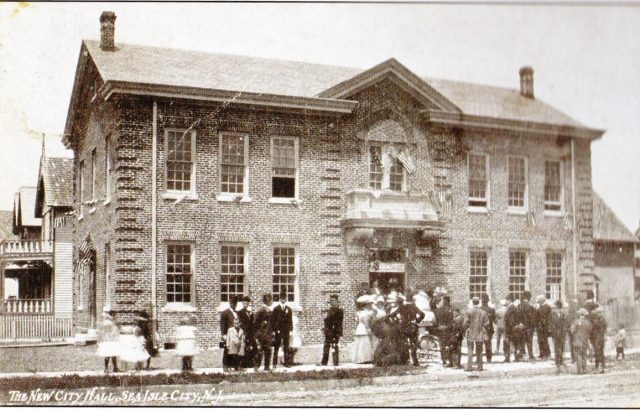BY BOB THIBAULT
In 1881, about 12 seconds after Charles Keith Landis threw open the doors to Sea Isle City, its first business was launched – that of selling land to whomever he could coax to invest in his new island utopia.
Landis established the initial infrastructure for Sea Isle. In effect, along with the ever-present ocean and the newbie railroad, he himself was the infrastructure. But he needed lots of help to build a self-sustaining city.
During its first decades, professionals and tradesmen of all kinds turned up in growing numbers in Sea Isle. What follows is a sketch of some of these initial enterprises. Much more information and hundreds of photos are available on the subject at the Sea Isle City Historical Museum.
Real Estate and Construction:
The first need was for a real estate business to accommodate the transfer of land from Charles Landis to prospective users. In the beginning, Landis himself took care of that, using his sister, Matilda, as his de facto agent. Then, other realtors appeared. Among them were Josef Scull on 40th Street and Lewis Steinmeyer who was to become mayor in 1910. To keep a rounded portfolio, some also sold insurance.
Sea Isle would need someone to build the 300 or so structures that were to fill the town by the end of the 19th century. There seemed to be no shortage of contractors and suppliers to do the job. As an example, the Cape May County Times in September, 1889, advertised six locals ready to get to work. There were many more. There had to be. It was big business even back then.
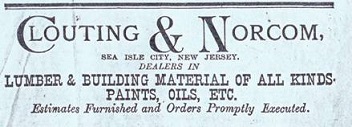
Builders needed materials, especially lumber. There were at least three early material suppliers in town: the Sea Isle City Lumber Company on the south side of JFK Boulevard; the Davis-Waddington Lumber Company on 38th Street; and Clouting and Norcom.
With assorted construction going full-blast all over town, some kind of organization seemed advisable to keep tabs on things. So in 1889 a Building Association was formed. (Whatever it did, or accomplished, is lost to history.) Then, in 1907, a formal Tradesmen’s Building & Loan Association was incorporated with Charles Clouting as president. It met once a week.
Fishing for Dollars:
There have always been fisherman in Sea Isle, but fishing as a business trade didn’t really get its start until the late 1890s when entrepreneurs such as Clarence and Walter Pfeiffer came to town to open their pound fishing companies. It was said that at one time there were seven such enterprises in the borough. It became Sea Isle’s main business, not counting tourism.
Fishermen needed boats. Clarence Pfeiffer ran a boat business out of his basement on 44th Street, in a house that he built and was later owned by Charles K. Landis. The Dever family and Frank Meader were two of the other boat builders in the 1890s.
As word got around, the early 1900s saw an influx of fishermen who emigrated from Italy to New York and Philadelphia, and then to Sea Isle. Familiar present-day names such as LaRosa, Raffa, Lamanna, Libro, and Monichetti began showing up. The Union and the Shallow Water fish companies were started. Within just a decade or so, Sea Isle City had become a leader in the fish exporting business.
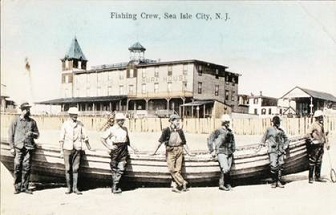
Professional Services:
With all this bustle in Sea Isle, there was a growing need for professional services. The town’s first dentist was a Barber – Dr. Harry Barber – reportedly a jovial man who nonetheless pulled teeth. But the best-known real barbers were Louis Braca and Michael Luongo who had emigrated from Italy on the same ship, and who ended up opening shops within a block of each other in Sea Isle. (Another barber, “Hurricane Sam” came along later. He was so named because he could cut hair in under seven minutes.) There was also another dentist, Dr. J.F. Leaming, who advertised that he visited Sea Isle on Wednesdays and gave gas.
George Urquhart, M.D. had his permanent office conveniently in the Acme Pharmacy on Landis Avenue. But he also stated that he would “visit any part of the county.” Sea Isle’s best-remembered early physician was Dr. Eugene Way, who would come to town from Dennisville about once a week and stay at Cronecker’s Hotel, until he decided to settle permanently in the city. It appears that the early medical and dental professionals were traveling men.
Where there are people, there are lawyers. Again, Charles Landis himself met the challenge with his office on the corner of 44th Street and Pleasure Avenue. Another firm, Leaming and Black – Counselors at Law, operated in Sea Isle, but only on Mondays.
Where there are people, there are also banks. The current 1st Bank of Sea Isle City (according to its website) traces its roots to 1888 when it was the Sea Isle Building and Loan, initially operating out of a private home. But Sea Isle’s first official bank charter was granted to the First National Bank of Sea Isle City in 1922. The first day’s deposit was $124,890, equivalent to almost two million dollars today.
The citizens of Sea Isle were naturally curious as to what was going on around them. In the early days, this desire was addressed by the Cape May County Times, founded in 1884 and published in town. The pages of the Times also met the need for advertising and provided all sorts of printed business forms – letterheads, menus, invoices, etc.
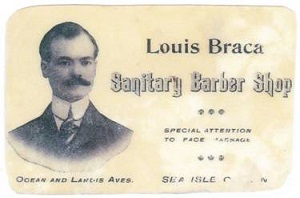
More Services:
As new needs arose, someone was usually there to accommodate them.
- In the 19th century, horsepower was the normal mode of transportation around the island, so a Mr. Woodruff opened a livery on 42nd Street west of Landis Avenue.
- Some visitors wanted to enjoy the ocean without actually going into it. The answer was the public bath house – which provided hot sea water baths on dry land. Sea water was pumped in under the Ocean Pier. Towels were supplied, but not washcloths.
- Everyone needed a little something to take along with him or her, so Bottlers sprung up around town. (Today we call them “Liquor Stores.”). One example was Thomas Clements who, in 1889, claimed that he had “all kinds of bottled goods on hand” to serve the public.
- People needed ice for their beverages, as well as for a few lesser applications like keeping meat fresh. So Sea Isle’s first two enterprising mayors, Martin Wells and Thomas Ludlam, joined together to open an ice business on 39th Street.
- With visitors streaming into town, and with new businesses shipping and receiving cargo, R.S. Muller came up with his “Baggage and Freight Express.” He even promised to move pianos carefully.
- With all the hotels and rooming houses in town, proprietors needed a place to wash their linens and such. Sam and Anna Dever opened the Ocean Laundry on 40th Street between Landis and Central Avenues (shown below). One of their biggest customers was the prestigious Continental Hotel.
- Businesses and even the city itself needed photographs to advertise their good points. Seascape photo ops were everywhere. Plus, even back then, everyone liked to get his or her picture taken, especially on vacation. So it’s surprising that there was only one professional photographer whose reputation survives. His name was Albert Amberg and his studio was located on the boardwalk in Sea Isle.
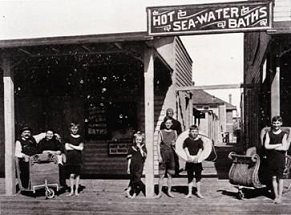
The list goes on. There was Buck the plumber, Goldberg the tailor, Assianti the shoe repair man, etc., etc. And this doesn’t even account for the almost endless number of food and merchandise stores which had proliferated throughout the town by the early 20th century. By then, Sea Isle had become a fully functional city.
To learn more about these early times in Sea Isle, please visit the Sea Isle City Historical Museum at 48th Street and Central Avenue. Hours are 10-3 Monday, Tuesday, Thursday, and Friday. Access our website at seaislemuseum.com, or call 609-263-2992.
This “Spotlight on History” was written by Sea Isle City Historical Society Volunteer Bob Thibault. Photos are provided courtesy of the Sea Isle City Historical Museum.

